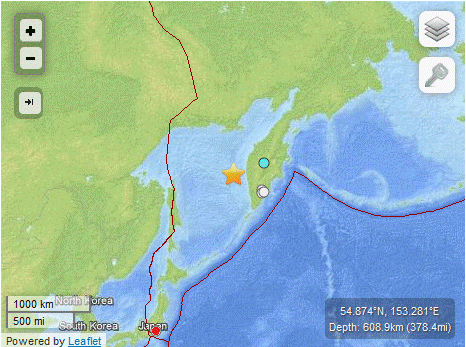On May 24, 2013 at 3:44 p.m. local time, a magnitude 8.3 earthquake struck deep below the Sea of Okhotsk about 406 km west-northwest of Petropavlovsk-Kamchatskiy, Russia. The earthquake occurred as the result of normal faulting at a depth of 609 km, according to the U.S. Geological Survey (USGS). Tremors were felt as far west as Moscow, more than 6000 km from the epicenter. This was the strongest deep earthquake ever recorded, surpassing the 640-km-deep magnitude 8.2 earthquake in Bolivia on June 9, 1994. In addition to the large amount of energy released, the Sea of Okhotsk earthquake was unique in that the rupture was the longest deep earthquake ever recorded (180 km long) and the rupture speed, 4 km/s (9000 mi/h), was about twice the velocity normally observed for deep earthquakes. See also: Earthquake; Fault and fault structures; Sea of Okhotsk

Deep earthquakes occur at depths of 400–700 km when a fault ruptures in a subducting slab of oceanic lithosphere. The 2013 Sea of Okhotsk earthquake was located where the Pacific Plate is being subducted beneath the Okhotsk Plate along what is known as the Kuril-Kamchatka subduction zone. Numerous deep earthquakes of lower magnitude have been recorded in this region. See also: Earth interior; Plate tectonics; Subduction zones
The mechanism of faulting and fracturing at great depth and extreme pressure is not well understood but is believed to result from the transformation of mineral forms. When a subducting slab exits the upper mantle at around 400 km depth, it enters a transition zone that extends to the lower mantle at about 700 km depth. Within this transition zone, the predominant mineral olivine [α-(Mg,Fe)2SiO4] is transformed to modified spinel [β-(Mg,Fe)2SiO4] and spinel [γ-(Mg,Fe)2SiO4] structures. This phase transformation of olivine to spinel is believed to weaken the slab, causing it to rupture. In September 2012, researchers at the U.S. Department of Energy’s Argonne National Laboratory reported in Science that when olivine experienced laboratory-simulated pressure and temperature conditions as found in the mantle transition zone, fractures were detected at the start of the phase transformation to spinel. Their results provide the best mechanism, to date, for how deep earthquakes occur. See also: Olivine





